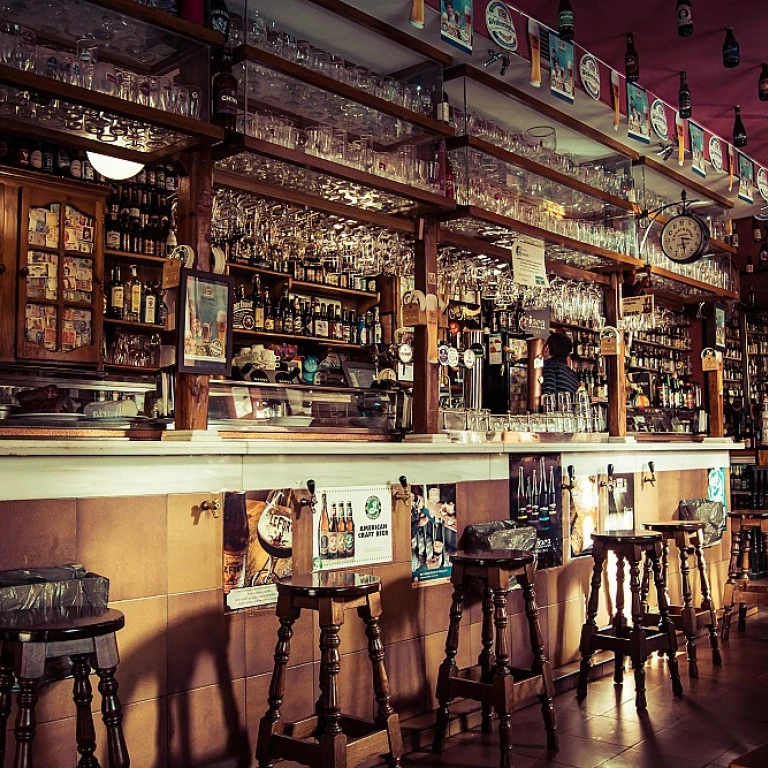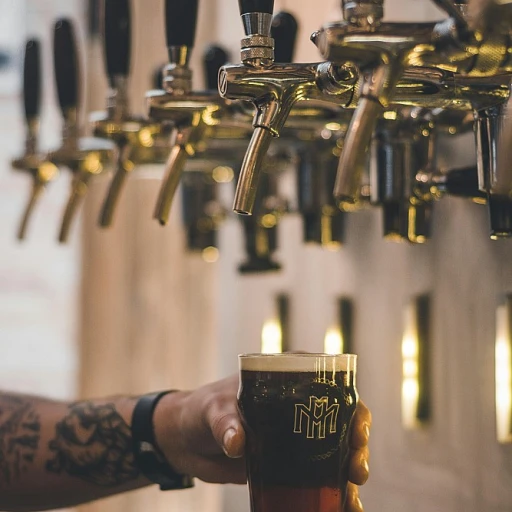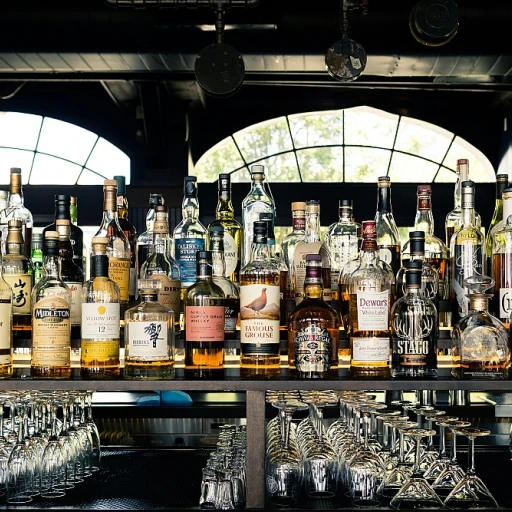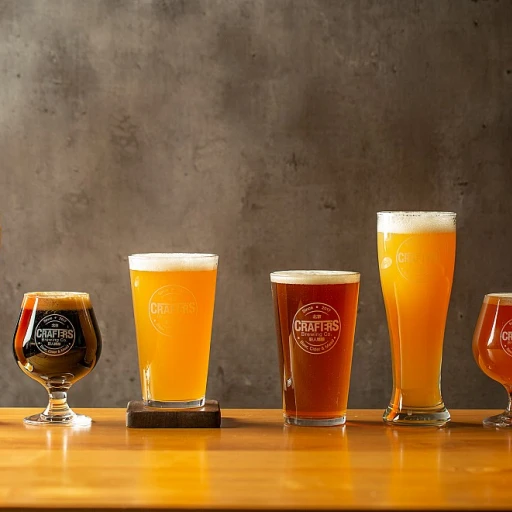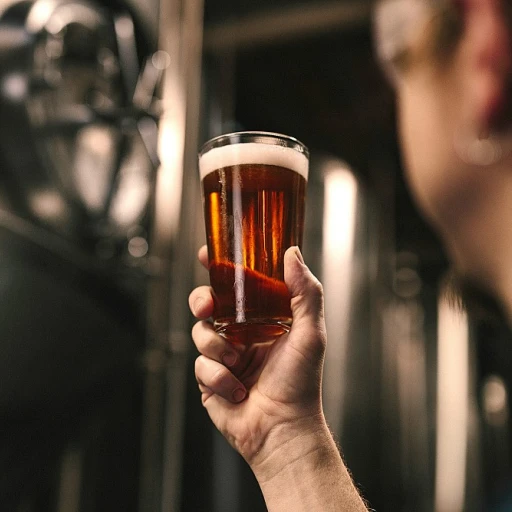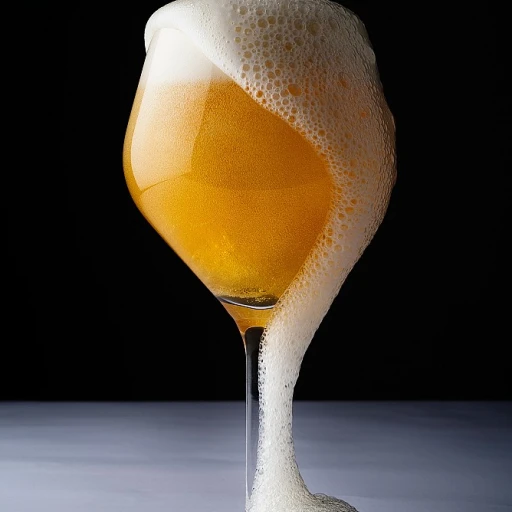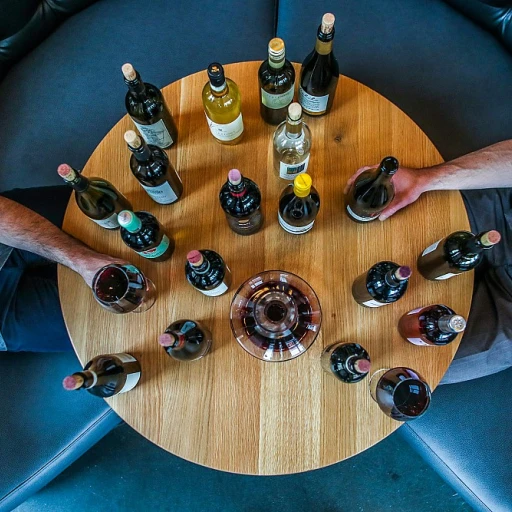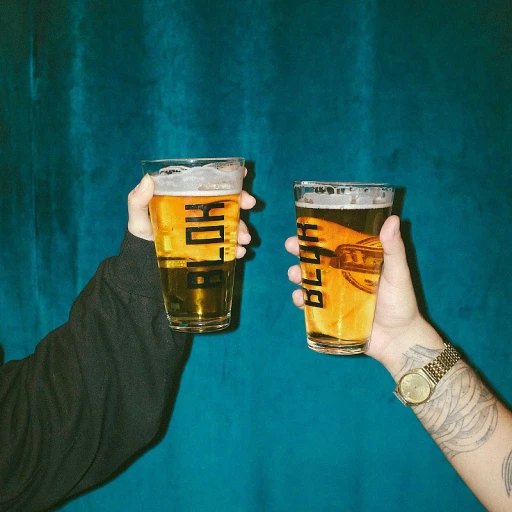The evolution of beer can design
Tracing the history: From tin cans to modern delights
The journey of beer can design is nothing short of fascinating. Once upon a time, beer came in heavy glass bottles, but everything changed in 1935 when canned beer hit the market with the introduction of the Krueger can. These early cans were made of steel and required a church key opener. Fast forward to 1959, and the first aluminum beer can was introduced by Coors, lightening the load for consumers and paving the way for the designs we're familiar with today.
Evolution to sleek and minimalistic designs
The can designs have evolved from simple branding to intricate artworks and sleek aesthetics that cater to modern consumers' tastes. For example, the rise of vector illustration and realistic mockups has enhanced the visual appeal of cans. These minimalistic designs are often paired with isolated white backgrounds, making the product stand out on the shelves.
The shift to sustainable packaging
Environmental concerns have pushed the industry toward more sustainable packaging. The beer industry, in particular, has embraced aluminum cans due to their recyclability. According to the Aluminum Association, nearly 75% of all aluminum ever produced is still in use today. This shift not only appeals to eco-conscious consumers but also aligns with global sustainability goals.
Design significance and consumer engagement
The design of a beer can is more than just about looks; it's a powerful tool for brand identity and consumer engagement. Take, for instance, the Allagash White and its distinctive can design, which is recognized instantly by beer aficionados across the United States. As per a report by Grand View Research, packaging has a significant impact on consumer purchasing decisions, with 72% of American consumers stating that packaging design influences their buying behavior.
Explore the fascinating history of unconventional beer flavors in this detailed blog post.
Why white beer cans are gaining popularity
The color psychology behind white beer cans
White beer cans have an undeniable appeal, and a key factor lies in the color psychology behind their design. There's an elegance to white; it's clean, pure, and minimalist, evoking a sense of freshness and simplicity. According to a study by the Institute for Color Research, colors like white are often associated with purity, safety, and cleanliness. This translates well in the context of beer, where the consumer might subconsciously associate a white can with a crisp, refreshing, and premium drinking experience.Expert insights on the appeal
Experts like Professor George R. Milner from Penn State University highlight that white cans help a beverage stand out on crowded shelves. "In a sea of multicolored cans, white can be a refreshing change, drawing the eye precisely because it breaks from the norm," says Milner. Additionally, the minimalist aesthetic can communicate quality and sophistication.Brand leaders such as Rob Tod, founder of Allagash Brewing Company, underscore this point. "When designing Allagash White's can, we wanted something that reflected the purity and subtlety of Belgian-style wheat beer. The understated white helped us communicate that message powerfully," Tod notes. This approach also aligns with broader market trends where consumers are increasingly drawn to products that exude transparency and authenticity.
Case studies: leveraging white for market success
Allagash White is a prime example of the successful use of white beer cans. As one of the top-rated beers in the United States, its branding plays a significant role in its popularity. The clean, minimalist design of the white can complements its reputation for being a top-notch Belgian-style wheat beer.Another interesting case is Not Your Father's Root Beer, which saw significant success with its similarly minimalist and nostalgic design. Their use of white elements in their branding added to a sense of heritage and quality, which helped boost their market image. Interested readers can explore more about their branding strategies in this detailed article.
The sales boost from white beer cans
White beer cans have also been proven to positively impact sales and marketing. A Nielsen report noted that products with simpler, cleaner aesthetics tend to outperform their more complex counterparts. This is especially true for the millennial demographic, who favor minimalist design and often associate it with premium quality.In conclusion, the rising popularity of white beer cans is no accident. Backed by strong color psychology, expert endorsements, and compelling case studies, these cans are helping brands stand out and boosting sales.
Expert insights on the appeal of white beer cans
Industry leaders' take on white beer cans
To delve into the attraction of white beer cans, we sought insights from industry experts who understand why these blank white aluminum treasures are catching consumers' eyes and wallets. Let's cut right to some raw opinions. John Hall, the Editor of Craft Beer and Brewing Magazine, states, 'White beer cans communicate cleanliness, purity, and a modern aesthetic. It's a blank canvas that brands use to signify simplicity and quality.' Indeed, the uncluttered look of a white beer can delivers a visual experience that resonates with the minimalistic and sophisticated tastes of today's market. When Allagash White decided to use white cans, they immediately saw an uptick in consumer interest, directly attributable to the design’s allure. Another noteworthy perspective comes from Megan Stone, a prominent Brewer and Advocate for Diversity in Craft Brewing. Megan relayed, 'The flexibility a white can offers in design isn't just about standing out; it also allows brands to easily adapt and innovate new looks. It's about more than just blank space; it's a strategy for appealing broadly without alienating any demographic.' Tom Blake, Marketing Director at a popular brewery, shared some revealing numbers. 'We found that our white beer can, introduced for a limited-edition IPA, boosted sales by 15% in just the first month. That’s more than our traditional designs have ever done in such a short period.' This statistic underscores not only the visual appeal but also the strategic advantage of utilizing a white canvas.Scientific look into consumer psychology
Research from a 2020 study by the Journal of Consumer Psychology delves into how colors influence buying behavior. It reveals that white evokes feelings of freshness and purity, which can make beverage products feel more refreshing and clean (Journal of Consumer Psychology, 2020). No wonder even energy drinks and sodas are adopting white cans for their summer editions! Further, a survey conducted by Nielsen in 2021 observed that 70% of millennials and Gen Z consumers prefer minimalist product designs, leaning towards products with white or simple color schemes (Nielsen, 2021). This demographic's preference aligns perfectly with the rise in popularity of white beer cans.More on the minimalist trend
The design community hails the isolated, blank, white background of these cans as modern art. It's a shift from the heavy, colorful packaging of past decades. Kat Dell, a renowned packaging designer, described white beer cans as 'the iPhone of the beer industry'. These isolated white backgrounds allow the brands to pop without overwhelming the senses. They symbolize a certain vector illustration that resonates with contemporary aesthetics, especially when mocked up against other stock illustrations.Examples of royalty-free icon design
The trend of white beer cans extends beyond big names. Smaller breweries are embracing this change, leveraging royalty-free icon designs, and using EPS files to manipulate, resize, and colorize labels easily. Companies like Vector Perfection provide editable layered files, making it easy for brewers to play with the icon design. This trend also extends into the digital domain—high-quality realistic vector illustrations and blank white cans are now commonly used in advertising mockups to convey a fresh, energetic vibe. In conclusion, the appeal of white beer cans is clear—purity, simplicity, and strategic market attraction. Their rise in popularity is anything but accidental; it's a calculated move reflecting broader consumer and design trends. For a further dip into Belgian traditions highlighted by fruity innovations, don't miss our Fruli Strawberry Beer: A Refreshing Blend of Belgian Tradition and Fruity Delight article.Case studies: successful brands using white beer cans
Showcasing allagash white and other standout brands
One standout example in the arena of white beer cans is Allagash White. This Belgian-style wheat beer, brewed by Allagash Brewing Company in Portland, Maine, has effectively embraced a minimalist design with its white can, aligning it with the crisp and refreshing nature of the beer within. Allagash White's can design has certainly played a role in its market success, emphasizing purity and simplicity which resonates with a wide range of consumers.
Another notable brand leveraging the white beer can design is Blue Moon, specifically its Belgian White variant. The use of a predominantly white can with subtle blue and orange accents not only highlights the beer's Belgian heritage but also makes it stand out on crowded shelves. This strategic use of color psychology can attract consumers who associate white with freshness and quality.
A study published by Grand View Research found that consumers are increasingly drawn to beverage packaging that conveys health, purity, and simplicity. This trend emphasizes why brands are now pivoting towards white and minimalist designs to appeal to modern buyers looking for authenticity and sophistication in their product choices.
The U.S.-based brewery, Oskar Blues, also made headlines with its White Can series, showcasing various beers and emphasizing the purity and quality message through its packaging. This move underlines a growing trend where breweries are prioritizing can designs that reflect the premium nature of their offerings.
Furthermore, Allagash White's success is cemented by its accolades. The beer consistently receives high marks from both critics and consumers, frequently appearing on 'best of' lists in various beer publications. Allagash founder Rob Tod has been quoted saying, "A well-designed can can be a game-changer in how a consumer perceives and enjoys our beer."
These cases underscore the importance of can design in the marketing and perception of beer. White beer cans not only catch the eye but also help convey a sense of modernity and cleanliness, tapping into current consumer preferences for healthy and down-to-earth products. With big name brands setting the trend, it’s likely we’ll see even more breweries adopting similar designs in the future.
The impact of white beer cans on sales and marketing
Boost in visibility and brand recognition
White beer cans are catching eyes on store shelves and fridge cases. Their clean, minimalistic design stands out amongst the more colorful, busy designs of other beer cans. According to a Nielsen report, products with simplified, clean design saw a 17% increase in sales compared to their more intricate counterparts. This boost in visibility translates into higher brand recognition and recall, leading to sales uptick.
Consumer preference for minimalist aesthetics
Today's consumers lean towards minimalistic aesthetics, something that white beer cans perfectly embody. According to a study conducted by McKinsey & Company, over 60% of consumers prefer packaging that is simple and easy to understand. The success of such designs is evident in the case of "Allagash White," a popular brand in the U.S. that leverages the simplicity of white cans to emphasize its premium quality and unique flavors.
Higher perceived value and premium image
White beer cans often convey a sense of purity and premium quality. This can influence consumer perceptions, driving them to associate white beer cans with higher product quality. For instance, in a survey by Packaging Digest, 45% of respondents felt that products in white packaging appeared more premium. Brands like Belgium’s Allagash have capitalized on this by reinforcing their artisan and high-quality image through white can designs, leading to increased sales.
Versatile design appeal
Another reason for the popularity of white beer cans is their versatile design appeal. White serves as a blank canvas, making it easier for brands to implement various design elements and tweaks. This flexibility allows for easy seasonal promotions or limited-edition variants. Unlike colorful designs, white cans can be quickly adapted to various trends without losing coherence with the brand’s overall identity.
Eco-friendly perceptions
Consumers are increasingly environmentally conscious. White beer cans tend to be perceived as more eco-friendly due to their cleaner look and potential recyclability. Trivium Packaging's 2020 Global Buying Green Report found that 74% of consumers are willing to pay more for sustainable packaging. Brands that use white beer cans often highlight their commitment to sustainability, resonating with eco-conscious buyers and driving sales.
Design elements of white beer cans
Choosing the right font and typography
The typography on a white beer can can make or break its appeal. Bold, sans-serif fonts often evoke a modern, fresh look, while more decorative fonts can add a touch of sophistication. According to a study by Behance, cans with clear, legible typography are 70% more likely to be picked up by consumers. It's all about making the text readable without overwhelming the design.
Take Allagash White, for instance. The can combines straightforward typography with iconic illustrations, creating a design that feels both approachable and distinct. This choice of typography is not only visually appealing but also speaks volumes about the brand’s identity.
Importance of color balance
While white is the primary color, balance is achieved through the use of complementary colors and hues. White cans often feature subtle accents in colors like gold, blue, or black to avoid looking too plain. This nuanced use of color can help highlight key elements like the brand name or flavor, making the can not just a container, but an artwork.
A report by the Color Marketing Group notes that colors are capable of increasing brand recognition by up to 80%. Therefore, the right color choices on a white beer can can significantly influence buying decisions.
Graphics and illustrations
White beer cans often incorporate minimalist graphics or hand-drawn illustrations to project a sense of craftsmanship and authenticity. According to Packaging Digest, 65% of consumers are attracted to products with unique and original packaging graphics. These illustrations can range from detailed brewery logos to simple but effective icons or patterns.
An excellent example is Allagash White, which features detailed, hand-drawn elements that reflect the brand’s artisanal approach. This not only makes the can visually intriguing but also broadcasts the quality and care put into the beer.
Use of water drops and textures
Adding textures like simulated water drops or matte finishes can make the white can more tactile and appealing. When done right, this gives consumers the impression of a cold, refreshing drink. According to a study by Insights Marketing, textured packaging can boost product attractiveness by 30%.
For example, the use of textures has been effectively employed in brands sold on Amazon, where the feel of the can in hand aligns with high consumer expectations for premium products. It’s a subtle but significant enhancement.
Consumer perceptions of white beer cans
Consumer preferences for white beer cans
White beer cans are attracting quite a bit of attention. Why? Because they scream sophistication and minimalism. They’ve rapidly shifted from being a niche choice to a trendy staple. In a world where aesthetic matters, white cans provide a clean, sharp look that many find appealing.
A recent Nielsen report revealed that beer packaged in visually appealing, minimalist cans saw a 15% faster growth in sales compared to traditional designs. The data doesn't lie, folks—the market is leaning towards cleaner designs, and white cans fit that bill perfectly.
Aesthetic appeal and minimalism
We spoke to industry expert Jessica Beltran, a designer at one of the top breweries in the U.S., and she explained, “It's about creating a blank canvas. White beer cans are versatile and adaptable to different branding elements. They allow the logo and artwork to pop without overwhelming the consumer.”
Experts suggest that white cans can even enhance the perceived quality of the beer. This perception aligns with consumer preferences for premium, craft beers, which are often more expensive. Simply put, white beer cans make the product look more 'elite' and 'artisan,' appealing to a demographic willing to spend more on their beverages.
Environmental impressions and sustainability
Another crucial aspect of consumer preferences is sustainability. With rising environmental concerns, consumers are more inclined to purchase brands that flaunt their commitment to eco-friendliness. White beer cans, especially those made of recycled aluminum, hit the right notes here.
Aluminum cans are one of the most sustainable packaging choices. According to the Aluminum Association, 75% of all aluminum produced in the U.S. is still in use today thanks to recycling. This ties into the ecological-conscious consumer’s mindset, making white cans preferable.
Psychological and visual factors
Let’s get into the psychology. Colors play a pivotal role in consumer behavior. White, often associated with purity and simplicity, offers a refreshing vibe. It taps into the subconscious, making the product feel cleaner and healthier. This approach isn’t just effective in the beer industry; it’s also prevalent in the soda and energy drink markets.
A study by the Journal of Marketing Research showed that colors significantly impact product perception. Consumers who associate the freshness of a white can with the beer it contains are more likely to make repeat purchases. It’s all about building a good first impression, which goes a long way.
Building brand loyalty
Brand loyalty cannot be overlooked. White beer cans achieve a particular uniformity that consumers can quickly identify. Take the success of Allagash White. Their use of white cans not only reinforces their brand identity but also makes their product easily recognizable on the shelves.
All these factors combined make white beer cans a powerful tool in the beer market today. Not just a trend, these cans are an evolving consumer favorite that build trust and loyalty.
Conclusion
So next time you reach for a beer, pay attention to the can's design—it might just be influencing your choice more than you think. If you're into the nitty-gritty of beer trends and packaging, you might also enjoy exploring the rise of other popular craft brews.
Future trends in beer can design
Emerging design trends in beer cans
The beer industry is always evolving, and the future of beer can design is no exception. There's a shift towards minimalistic and modern designs, with an emphasis on clean, simple aesthetics. White beer cans are leading this trend due to their versatility and ability to make other colors and designs pop. According to a Canmaker report, 65% of new beer can designs in 2022 embraced a minimalist approach, largely influenced by the success of white backgrounds. This trend is not just about aesthetics; it's also about functionality and sustainability.
1. Sustainability
Environmental concerns are pushing breweries to rethink their packaging. White beer cans, often produced with fewer dyes and chemicals, are easier to recycle. The U.S. Environmental Protection Agency (EPA) reported that aluminum cans have a recycling rate of 50%, but simpler designs like white cans can push this rate higher by reducing contamination from inks and coatings (EPA Report).
2. Digital Integration
With the rise in technology, beer can designs are getting smarter. Breweries are incorporating QR codes and AR (Augmented Reality) elements into their labels. This allows consumers to scan the can with their smartphones and access interactive content like brewery tours, tasting notes, and promotions. Allagash Brewing Company, known for its Allagash White, has successfully integrated such features, enhancing consumer engagement and brand loyalty (Allagash).
3. Customization Trends
Customization is another growing trend. With advancements in digital printing technology, breweries can create unique and limited-edition designs quickly and efficiently. This can cater to seasonal themes, special events, or collaborations with artists. Brands like Washington's own Blood and Honey are pioneers in leveraging this trend to stand out in a competitive market.
4. Hand-Drawn Illustrations
Hand-drawn illustrations and artisanal designs are gaining traction as consumers seek authenticity and uniqueness. These designs often involve intricate details and a personal touch, setting them apart from mass-produced graphics. Vector illustration, especially in EPS files, provides high-quality, scalable designs that maintain detail in various sizes and formats.
Expert Insights
"White beer cans represent the future of beer packaging, combining clean aesthetics with functional benefits. Brands adopting these trends are likely to see significant boosts in brand perception and customer engagement," says Mike Stevens, CEO of Founders Brewing Co.
The use of white cans, supported by trends in sustainability, digital integration, customization, and hand-drawn illustrations, is setting new standards in beer can design. Expect to see more brands embracing these trends in the coming years, making your next beer purchase not just a choice of taste but also of artistic and environmental value.

